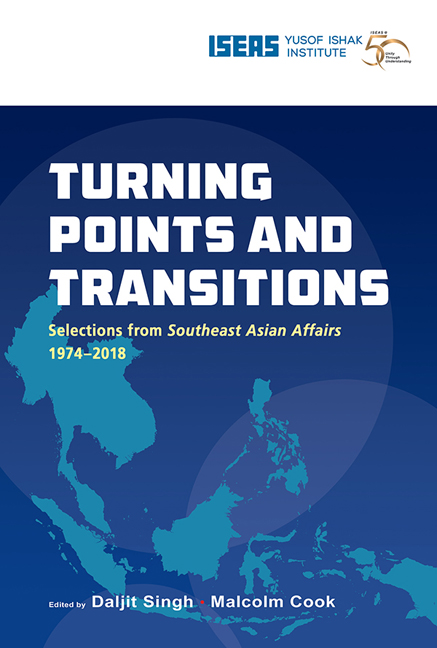Book contents
- Frontmatter
- Contents
- Message from the Director
- Foreword
- Foreword
- Introduction
- THE REGION
- The Diplomatic Emergence of China and Its Implications for Southeast Asia (1975*)
- Stability and Security in the Region after ANZUK (1975)
- The Question of the “Overseas Chinese” (1976)
- Southeast Asia 1976: The Handling of Contradictions (1977)
- The “Fukuda Doctrine” and Its Implications for Southeast Asia (1978)
- Expanding Horizons in Southeast Asia? (1994)
- AFTA in the Light of New Economic Developments (1995)
- The ASEAN Economic Miracle Unravels (1999)
- Southeast Asia in 1999: A False Dawn? (2000)
- East Timor's Future: Southeast Asian or South Pacific? (2001)
- Southeast Asia in 2002: From Bali to Iraq — Co-operating for Security (2003)
- The Year in ASEAN: The Charter, Trade Agreements, and the Global Economic Crisis (2010)
- Seeking Stability in Turbulent Times: Southeast Asia's New Normal? (2015)
- China's Two Silk Roads Initiative: What It Means for Southeast Asia (2015)
- China's International Strategy and Its Implications for Southeast Asia (2016)
- BRUNEI
- CAMBODIA
- INDONESIA
- LAOS
- MALAYSIA
- MYANMAR
- THE PHILIPPINES
- SINGAPORE
- THAILAND
- VIETNAM
AFTA in the Light of New Economic Developments (1995)
from THE REGION
Published online by Cambridge University Press: 29 May 2019
- Frontmatter
- Contents
- Message from the Director
- Foreword
- Foreword
- Introduction
- THE REGION
- The Diplomatic Emergence of China and Its Implications for Southeast Asia (1975*)
- Stability and Security in the Region after ANZUK (1975)
- The Question of the “Overseas Chinese” (1976)
- Southeast Asia 1976: The Handling of Contradictions (1977)
- The “Fukuda Doctrine” and Its Implications for Southeast Asia (1978)
- Expanding Horizons in Southeast Asia? (1994)
- AFTA in the Light of New Economic Developments (1995)
- The ASEAN Economic Miracle Unravels (1999)
- Southeast Asia in 1999: A False Dawn? (2000)
- East Timor's Future: Southeast Asian or South Pacific? (2001)
- Southeast Asia in 2002: From Bali to Iraq — Co-operating for Security (2003)
- The Year in ASEAN: The Charter, Trade Agreements, and the Global Economic Crisis (2010)
- Seeking Stability in Turbulent Times: Southeast Asia's New Normal? (2015)
- China's Two Silk Roads Initiative: What It Means for Southeast Asia (2015)
- China's International Strategy and Its Implications for Southeast Asia (2016)
- BRUNEI
- CAMBODIA
- INDONESIA
- LAOS
- MALAYSIA
- MYANMAR
- THE PHILIPPINES
- SINGAPORE
- THAILAND
- VIETNAM
Summary
Introduction
It was at the 1992 Association of Southeast Asian Nations (ASEAN) Summit that the six states made a stronger commitment to a liberal trade regime through the instrument of the Common Effective Preferential Tariff (CEPT). They decided to establish an ASEAN Free Trade Area (AFTA).
Coming on the heels of the North American Free Trade Agreement (NAFTA) and Europe 1992, AFTA did not evolve from a comprehensive and detailed programme of liberalization complete with rules and procedures. In fact the agreement incorporating AFTA was less than 10 pages. Compare this with the NAFTA document exceeding 2,000 pages. Yet AFTA stands out among all attempts in ASEAN at economic co-operation in several ways. First, this was the first time that ASEAN described free trade as its eventual goal, a break from its previous mind-set of cautious liberalization. Second, the Heads of Governments in ASEAN identified 15 product groups for accelerated liberalization, thus avoiding a lengthy process of negotiations among bureaucrats to identify product groups, Third, there was a definite timetable within which free trade would be achieved, that is in 15 years. Finally, the CEPT was a vast improvement over an earlier (1987) programme for enhanced Preferential Trading Arrangements (PTA), which allowed for more automatic liberalization of items, deeper margins of preferences, and more product coverage than under PTA. This latter programme did not really progress substantially, suffered from delays in submission of items for liberalization, and some members were behind schedule for as much as two years.
As shown in Figure 1, the CEPT has two tracks: fast and normal. In the fast track, according to the 1992 agreements, the achievement of free trade was to take place in 10 years, that is by 2003. For items with base tariff rates exceeding 20 per cent, reductions were to be spread over 10 years till 2003. For items with rates below 20 per cent, reductions were to be completed by the year 2000.
In the normal track, tariffs of more than 20 per cent were to be reduced in three stages: to 20 per cent by 2001, 15 per cent by 2003, 10 per cent by 2005 and free trade (0–5 per cent) in 2008. For items with tariff rates less than 20 per cent, reductions were to be completed by 2003.
- Type
- Chapter
- Information
- Turning Points and TransitionsSelections from Southeast Asian Affairs 1974-2018, pp. 67 - 78Publisher: ISEAS–Yusof Ishak InstitutePrint publication year: 2018

